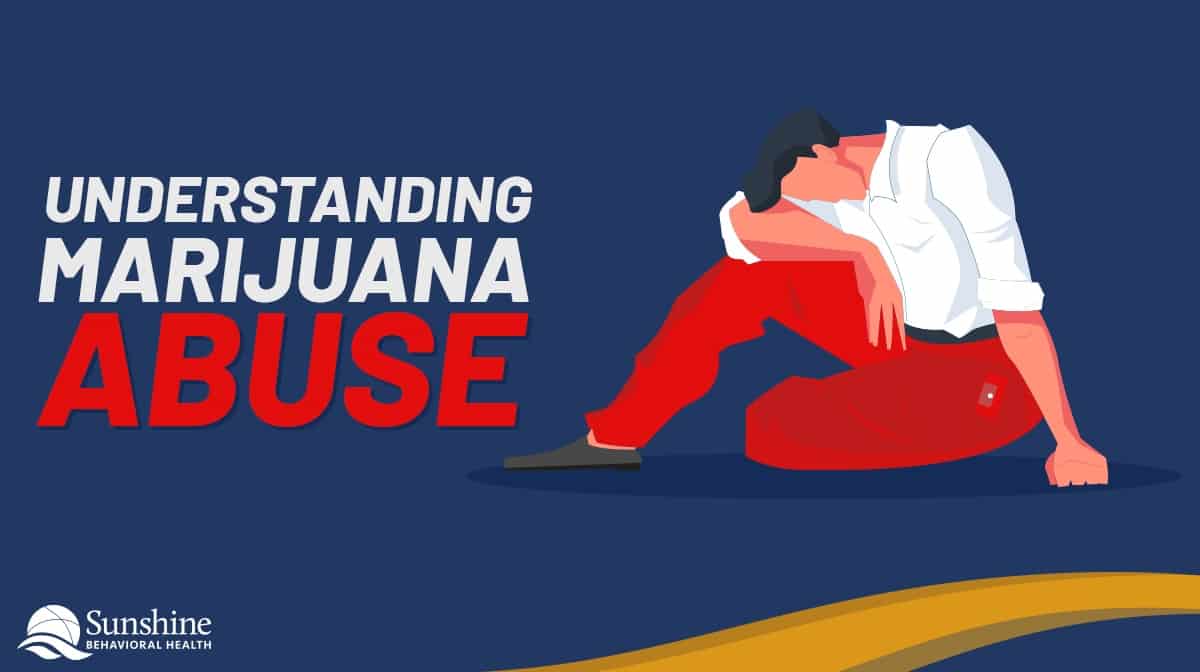Marijuana Use Statistics: What You Need To Know
Marijuana use disorder is characterized by an unhealthy dependence on marijuana. While some people occasionally use the drug legally and/or recreationally, others find that they become dependent on marijuana for daily functioning.
People who are living with marijuana use disorder experience uncomfortable symptoms when they don’t have the drug. Also known as withdrawal symptoms, they may include restlessness, decreased appetite, irritability, mood problems, sleep issues, physical discomfort, and other problems. For most people, these symptoms are at their worst about a week after ending their marijuana use and tend to fade at the two-week mark.
When someone smokes large amounts of marijuana regularly, their brain chemistry can change. The brain naturally produces endocannabinoid neurotransmitters. When the brain receives these chemicals through marijuana, it stops producing them naturally.
The period between the cessation of marijuana use and the brain’s natural rebuilding of endocannabinoid neurotransmitters can create the withdrawal symptoms listed above.
Misuse of marijuana could lead to marijuana use disorder and other negative consequences including addiction. Here, we’ll take a look at how different demographics experience issues with marijuana use.
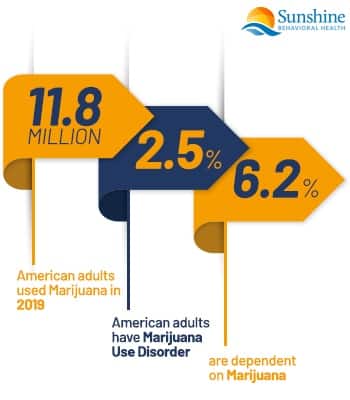
Statistics in Adults
Many people are curious about the number of people who use marijuana. More than 11.8 million American adults reported using marijuana at some point in 2019. Marijuana facts and stats show that more than half of American adults have tried marijuana at some point.
Marijuana use disorder studies indicate that approximately 2.5% of American adults currently meet the criteria for marijuana use disorder, and up to 6.2% of adults exhibited symptoms that would classify them as addicted to or dependent on marijuana at some point in their lives.
Statistics by Age
Statistics show a large disparity in marijuana use between different age groups.
According to Statista, 22% of Americans between the ages of 18 and 29 smoke marijuana regularly. A smaller percentage of 30-49-year-olds, 11%, report regular marijuana use. Marijuana usage statistics show that 12% of 50-64-year-olds smoke marijuana, while just 3% of Americans age 65 and older smoke marijuana.
Of course, statistics on smoking marijuana regularly are not necessarily indicative of how many people abuse the drug. It’s important to remember that a percentage of people — around three out of every ten marijuana users, according to marijuana addiction stats — live with marijuana use disorder.
Statistics by Gender
Men are more likely than women to use drugs, and marijuana is no exception. Interestingly, women are just as likely as men to experience marijuana use disorder and other types of substance use disorders. Women may be more likely than men to struggle with recovery’s craving and relapse phases.
Statistics in Seniors
More older adults have been using marijuana in recent years. Legalization, changing views, and lack of stigma are all possible reasons for this increase.
From 2015 to 2018, marijuana use among Americans ages 65 and older rose from 2.4% to 4.2%. While some adults in this age group experimented with drugs in the past, others are new to the idea of using marijuana. Part of this increase may be due to the medicinal properties of marijuana, especially for dealing with chronic pain.
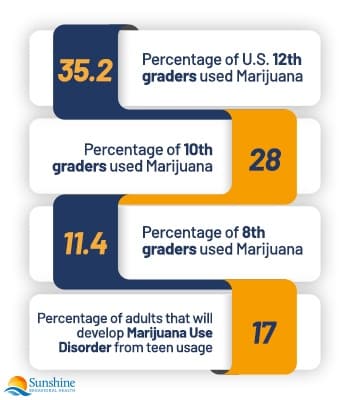 Statistics in Teens
Statistics in Teens
If you’re curious about how many teenagers use marijuana, you’re not alone. The 2020 Monitoring the Future Study stated that 35.2% of U.S. 12th graders, 28% of 10th graders, and 11.4% of eighth-graders claimed to have used marijuana in the past year.
During the teenage years, marijuana use can be particularly harmful. Statistics about marijuana show approximately 17% of the people who start using marijuana in their teens will eventually develop marijuana use disorder.
Statistics in Prepubescents
There are few studies on the effects of marijuana use in prepubescent children. Animal studies have shown delays in sexual maturity due to marijuana use, and it’s possible that these effects could occur in humans as well.
Statistics by Employment Status
It can be difficult to decipher the link between marijuana use disorder and unemployment. It’s possible that people who are struggling with unemployment may turn to marijuana for stress relief and eventually develop marijuana use disorder. It’s also possible that people who are living with marijuana use disorder struggle at work, leading to difficulty maintaining a steady job.
Studies show that approximately 18% of people who are unemployed have used marijuana in the previous month, but this does not necessarily mean that these people are living with marijuana use disorder.
Statistics by Ethnicity
Studies on marijuana use disorder show that Black, Native American, and mixed-race adults are more likely to experience the disorder than white adults.
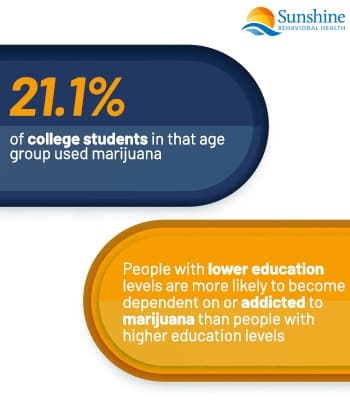
Statistics by Education Level
Students currently enrolled in college are slightly less likely to use marijuana than those not enrolled in college. In 2019, studies show that 22.7% of all people aged 18-22 used marijuana, while 21.1% of college students in that age group used marijuana.
People with lower education levels are more likely to become dependent on or addicted to marijuana than people with higher education levels.
Marijuana use has never been higher among college students. It’s possible that the availability of marijuana vaporizers (vapes) has caused an increase in use on college campuses.
Driving Under the Influence of Marijuana Stats
In 2019, there was a sharp spike in the number of people who drove under the influence of marijuana. In 2018, 4.7% of people 16 and older reported driving after using marijuana. The statistics are particularly troubling for the 16-25-year-old age group, as 10.8% of drivers in that group reported driving under the influence of the drug.
While research has yet to pin down the exact effects of marijuana on driving ability, the Centers for Disease Control and Prevention (CDC) says that people who drive after using marijuana are 25% more likely to get into a car accident than people who drive sober.
Marijuana Usage by State
There are vast differences in marijuana use across the United States. Washington, D.C., has the highest rate of marijuana use, with 27% of adults reporting use in the past year. The U.S. states of Washington, Colorado, Vermont, and Oregon are also heavy-use areas, with more than 25% of adults reporting use in each state in the past year.
States with the lowest rates of marijuana use include Mississippi, South Dakota, Texas, Louisiana, and Virginia, all with previous-year adult usage rates below 13%.
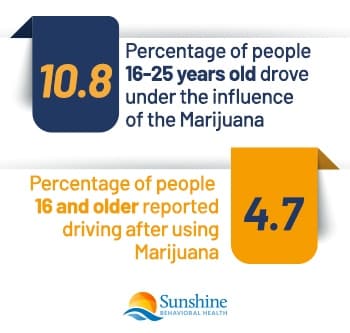
Overdose Stats About Marijuana
There’s an ongoing debate about whether it’s possible to overdose on marijuana. A coroner thinks it may have happened, while others say marijuana overdoses are highly unlikely.
Since using too much marijuana is typically regarded as uncomfortable but not fatal, it’s hard to gather data on exactly how many people use too much marijuana each year. Symptoms of using too much marijuana mimic side effects from standard cannabis use. People who smoke or otherwise ingest too much marijuana may experience paranoia, hallucinations, delusions, rapid heart rate, and extreme confusion.
While overdoses from marijuana alone are unlikely, it’s highly possible to overdose on a combination of marijuana and other drugs. Using K2 or spice — synthetic marijuana — has unpredictable effects and may be more likely to cause an overdose.
Rates of Relapse
Many people who go through treatment for marijuana use disorder have great success in staying clean over time. Studies show that fewer than 7% of people in recovery from marijuana use disorder experience relapse.
Statistics on Treatment and Recovery
Treatments proven most effective for marijuana use disorder include:
- Cognitive-behavioral therapy (CBT)
- Motivational enhancement therapy (MET)
- Contingency management (CM)
Research suggests that treatment is most effective when all three therapy methods are combined.
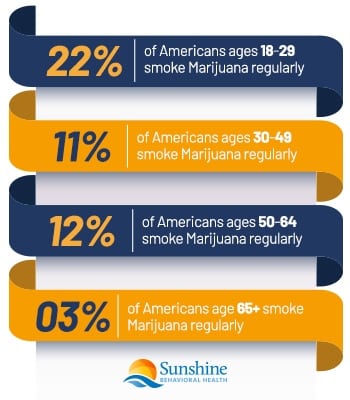
Marijuana Abuse Is Real, and Assistance Is Available
If you or a loved one are dealing with marijuana abuse or addiction, it can be tough to find the help you need to begin the recovery process. Learning some statistics about marijuana can be the first step to understanding the problem. Take a look at the following recovery resources to learn more about the support and programs available to help treat problems with marijuana.
National Institute on Drug Abuse — Available Treatments for Marijuana Use Disorders
The National Institute on Drug Abuse (NIDA) is a non\partisan government organization that works to inform the public of the dangers, symptoms, and treatments available for drug abuse. NIDA recognizes the reality of marijuana addiction and offers helpful information for both people suffering from marijuana addiction and their family members.
Substance Use Disorder and Mental Health Services Administration — Behavioral Health Treatment Locator
If you’ve recently realized that you or a loved one are dealing with marijuana addiction, it can be tough to know where to turn. The Substance Use Disorder and Mental Health Services Administration (SAMHSA)’s behavioral health treatment locator can help. This tool can show you addiction treatment services in your area and can provide the information necessary to help you narrow your search for treatment.
Addiction Science and Clinical Practice — Marijuana Dependence and Its Treatment
As you seek treatment for addiction to marijuana, you may hear some debate as to whether it’s possible to be addicted to a plant-based substance. This study provides valuable insight into marijuana abuse and addiction.
Sources
Medical disclaimer:
Sunshine Behavioral Health strives to help people who are facing substance abuse, addiction, mental health disorders, or a combination of these conditions. It does this by providing compassionate care and evidence-based content that addresses health, treatment, and recovery.
Licensed medical professionals review material we publish on our site. The material is not a substitute for qualified medical diagnoses, treatment, or advice. It should not be used to replace the suggestions of your personal physician or other health care professionals.
